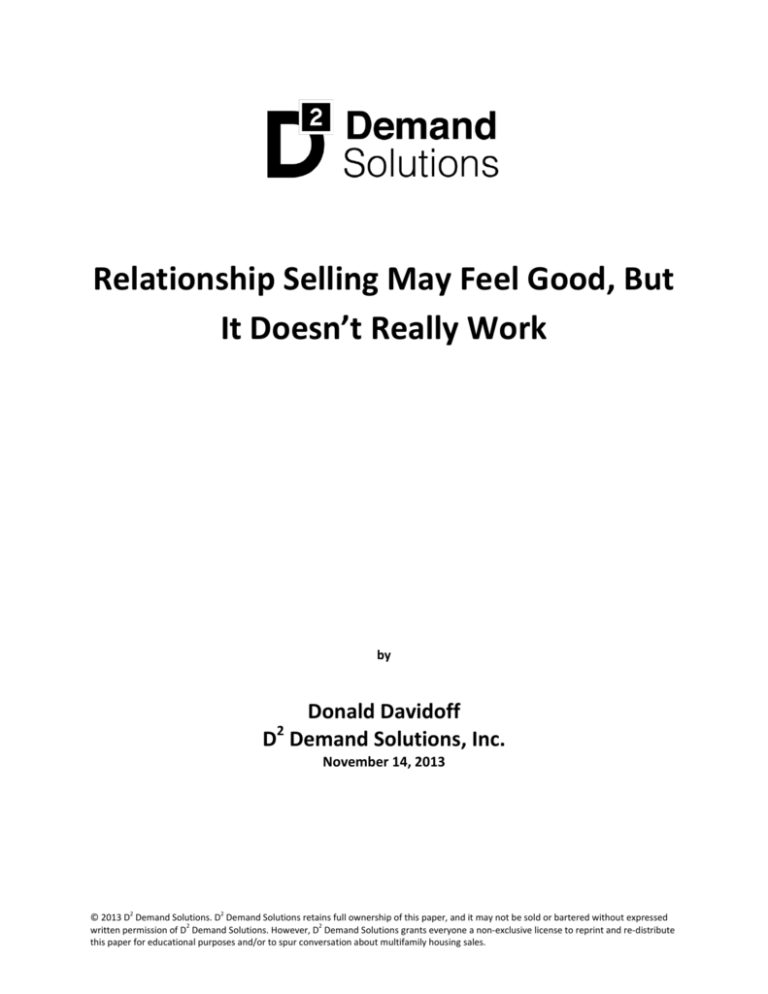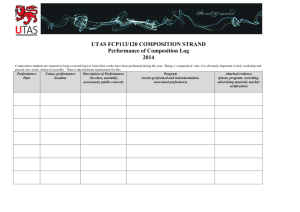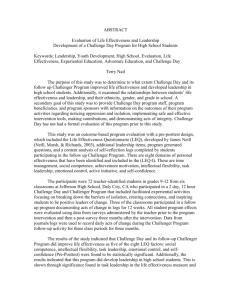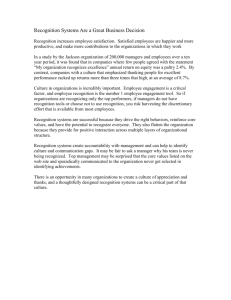Relationship Selling May Feel Good, But It Doesn't Really Work
advertisement

Relationship Selling May Feel Good, But It Doesn’t Really Work by Donald Davidoff D Demand Solutions, Inc. 2 November 14, 2013 © 2013 D2 Demand Solutions. D2 Demand Solutions retains full ownership of this paper, and it may not be sold or bartered without expressed written permission of D2 Demand Solutions. However, D2 Demand Solutions grants everyone a non-exclusive license to reprint and re-distribute this paper for educational purposes and/or to spur conversation about multifamily housing sales. Introduction Now that’s a provocative title, isn’t it? What do you mean relationship selling doesn’t work? Of course you need to be able to build relationships to sell, don’t you? Before anyone gets too excited, let’s be clear about two things: 1. I’m not the one saying this. It’s coming from some very detailed research. The kind of numbersbased analysis that is a) exactly what I like to base decisions on and b) all too often missing from conversations in sales anywhere but particularly in multi-family housing 2. I’m not saying relationships are unimportant. But the real question is whether the relationships you are building are of the “I like you” kind that emphasizes reducing sales tension or the “I value you” kind that actually recognize and manage the natural tension inherent in big ticket sales situations. The Research Back in 2009, the Corporate Executive Board conducted some seminal research in the field. Specifically, they interviewed 600+ sales people (since expanded to several thousand) and measured them across several dozen dimensions. They went in with no pre-conceived notions, and used a statistical process known as “cluster analysis” to identify various selling styles (note: these are business behavioral styles not personalities per se). To their surprise, they found there were basically only 5 clusters of sales styles: 1. Lone Wolves are the closest thing to the “born sales person.” These are the people who tend to rely solely on their wit and charm and react in the moment. They tend not to use a lot of corporate resources and will often go “off book” from whatever process they’ve been trained to use. 2. Problem Solvers are the darlings of “consultative selling.” They dig deeply into what prospects say their problems are and quickly offer up how their products can solve those problems. 3. Hard Workers are those salespeople who are always working the phone and following up on appointments they get just by the sheer number of prospects they contact. They work long hours and frankly their sales seem to come more from “the law of averages” than particularly sophisticated sales behaviors 4. Relationship Builders are the ones who seem to get to know everyone, and everyone seems to like them. They can get a meeting with just a phone call. They can describe in detail exactly what role each stakeholder plays and their prospects seem to truly enjoy meeting with them. 5. Challengers are a type of sales person that the researchers had no idea they would find. Challengers never take the status quo as given. They are always digging into what is beneath the surface for answers to questions. They frequently suggest that the problem a prospect thinks they have is really just a symptom of a much broader and/or deeper underlying problem that is much more important to attack. But the research didn’t stop there. The Corporate Executive Board asked the companies involved to identify which sales associates were high performers and, perhaps more importantly, which were “core © 2013 D2 Demand Solutions. D2 Demand Solutions retains full ownership of this paper, and it may not be sold or bartered without expressed written permission of D2 Demand Solutions. However, D2 Demand Solutions grants everyone a non-exclusive license to reprint and re-distribute this paper for educational purposes and/or to spur conversation about multifamily housing marketing. 2 performers” (i.e. “middle of the pack”) so that they could compare them to determine what seemed to differentiate the two. Note that they did NOT compare high performers to low performers but instead, focused on the middle-of-the-road performers. That’s because the biggest improvement would come from moving the large middle group forward and not focusing on the bottom few. In sales, candidly the bottom few probably need to be counseled up or out. What they found was truly astonishing. 1. “Core performers” are spread relatively similarly across all 5 clusters of sales styles. In other words, any kind of sales approach can achieve average results 2. In contrast, “high performers” are clearly over-represented in just two clusters: Challengers and Lone Wolves with Challengers representing significantly more than Lone Wolves. In other words, there’s a roadmap for what kind of approach is most likely to drive high performance. 3. Perhaps most strikingly, Relationship Builders are severely under-represented among high performers. In fact, they come in a distant 5 out of 5. Source: CEB White Paper, The New High Performer, 2009 Implications for Multi-Family Housing Sales Like many industries, most in multi-family have been emphasizing “relationship selling” as the core model for hiring and training leasing associates. Clearly, the research shows that this approach is extremely unlikely to lead to high performing sales behaviors. Instead, we should focus on the two clusters most likely to lead to high performance; and since “lone wolves” are by definition not easy to train, our primary focus should be on identifying individuals who can implement the Challenger model. The literature uncovered three key things a Challenger sale associate does that others don’t: 1. Teach. Challenger salespeople don’t “sell” in the classic sense. Rather than jumping into product offerings and demonstrations quickly, they probe deeply for underlying causes to their prospects problems. They truly “seek first to understand.” They take the knowledge and © 2013 D2 Demand Solutions. D2 Demand Solutions retains full ownership of this paper, and it may not be sold or bartered without expressed written permission of D2 Demand Solutions. However, D2 Demand Solutions grants everyone a non-exclusive license to reprint and re-distribute this paper for educational purposes and/or to spur conversation about multifamily housing marketing. 3 experience they have from prior transactions and market research to share critical insights1 with prospects. In other words, they teach their prospects something about themselves and their real problems that the prospect wouldn’t otherwise know. 2. Tailor. Based on what the Challenger salesperson has learned, she tailors her presentation to the actual needs and tone of the prospect. Many salespeople make the mistake a following an “ask, answer, respond” model in which he asks a question, the prospect responds and then the salesperson feels compelled to connect his product to the just-identified need. The problem with this approach is that, to the prospect, the answer is just another in a series of “salesy” encounters. The Challenger salesperson follows a radically different approach, one in which she follows an “ask, answer, ask, answer, … present” model. She holds off presenting any position of advocacy until she totally understands the prospect’s needs and has developed trust through getting to know the prospect and intentionally withholding talking too early about her product. 3. Take Control. Lastly, a Challenger salesperson takes control of the conversation. This requires the emotional intelligence to be assertive without being aggressive. It means she’s able to “push” the conversation without being pushy, and she’s comfortable discussing price. She doesn’t shy away from challenges or difficult parts of the discussion. As Neil Rackham, author of the seminal book, SPIN Selling, notes, “In my own research, I saw some reps losing more customers to cheaper suppliers late in the sale because they failed to take control early on. They steered clear of having a tough conversation about the [money], fearing it would damage the relationship.”2 Conclusion Our multi-family industry suffers from the same myth that “relationship selling” is the key to success that most other verticals have believed. The research clearly shows that, for a wide range of other industries, the reality is that “relationship selling” is actually the least likely style for high performers to use. The good news is that what comes naturally to the Challenger salesperson is a set of skills that are teachable. This contrasts with the only other style highly represented among high performers (the Lone Wolf) which is much more about charisma and natural talent and is thus not really teachable. Multi-family executives interested in maximizing their sales teams’ performance should abandon the “relationship sales” model and invest in creating a sales system and the concomitant sales training that would teach their associates how to successfully implement a multi-family sales model based on the concepts and principles of the Challenger Sales Approach. 1 The authors of the original study acknowledge that, in hindsight, the terminology “challenger sales” has often been misinterpreted. In a recent Harvard Business Review article, they’ve been using the term “insight sales” which is less threatening and, in this author’s opinion, more descriptive. 2 Dixon and Adamson, Matthew and Brent. The Challenger Sale: Taking Control of the Customer Conversation, Portfolio/Penguin 2011, page 123 © 2013 D2 Demand Solutions. D2 Demand Solutions retains full ownership of this paper, and it may not be sold or bartered without expressed written permission of D2 Demand Solutions. However, D2 Demand Solutions grants everyone a non-exclusive license to reprint and re-distribute this paper for educational purposes and/or to spur conversation about multifamily housing marketing. 4 Contact Information D2 Demand Solutions, Inc. 9656 West Danzig Place Littleton, Colorado 90127 (303) 588-1389 Donald@d2demand.com © 2013 D2 Demand Solutions. D2 Demand Solutions retains full ownership of this paper, and it may not be sold or bartered without expressed written permission of D2 Demand Solutions. However, D2 Demand Solutions grants everyone a non-exclusive license to reprint and re-distribute this paper for educational purposes and/or to spur conversation about multifamily housing marketing. 5







